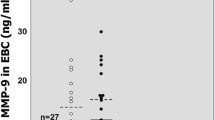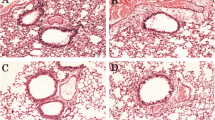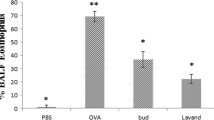Summary
To investigate the effect of the Ginkgo Biloba Extract (GBE) on the asthma and examine its possible mechanisms, 75 asthma patients were divided into 4 groups and the patients were respectively treated with fluticasone propionate for 2 weeks or 4 weeks, or treated with fluticasone propionate plus GBE for 2 weeks or 4 weeks. Fifteen healthy volunteers served as healthy controls. Sputum inhalation with inhaling hypertonic saline (4%–5%) was performed. Lung ventilatory function and forced expiratory volume in one second (FEV1) were measured. The numbers of different cells in induced sputum were calculated. The expression of PKCα in the cells was immunocytochemically detected and the percentages of positive cells in different cells were counted. Interleukin-5 (IL-5) in sputum supernatants was detected with enzyme-linked immunosorbent assay. The percentage of eosinophils, lymphocytes, PKCα positive inflammatory cells and the concentration of IL-5 in asthmatic patients were higher than those in the controls (P<0.05), and the eosinophils, lymphocytes, positive expression of PKCα and the level of IL-5 were significantly decreased in asthmatic patients after they were treated with fluticasone propionate or fluticasone propionate plus GBE. However, they were still significantly higher than those of the controls. Compared to the group treated with glucocorticosteroid for 2 weeks, no significant decrease was found in the percentage of eosinophils, lymphocytes, PKCα positive inflammatory cells and the IL-5 in the supernatant of induced sputum. Compared with the group treated with glucocorticosteroid for 2 or 4 weeks, significant decrease in the same parameters was observed in the group treated with fluticasone propionate and GBE for 4 weeks. The IL-5 level in the supernatant of induced sputum was positively correlated with the percentage of PKCα-positive inflammatory cells and the percentage of eosinophils in the induced sputum in asthma patient groups respectively (n=150, r= 0.83, P<0.01; n=150, r=0.76, P<0.01). The FEV1 was negatively correlated with the percentage of PKCα-positive inflammatory cells and the IL-5 levels in supernatant of induced sputum in asthma patients respectively (n=150, r=−0.77, P<0.01; n=150, r= −0.64, P<0.01). It is concluded that GBE could significantly decrease the infiltration of inflammatory cells such as eosinophils and lymphocytes in the asthmatic airway and relieve the airway inflammation. GBE may decrease the activation of the PKCα in the inflammatory cells and thereby decrease the IL-5 level in induced sputum. GBE may be used as a complement to the glucocorticosteroid therapy for asthma.
Similar content being viewed by others
References
Agrawal D K, Bharadwaj A. Allergic airway inflammation. Curr Allergy Asthma Rep, 2005,5:142–148
Jaracz S, Stromgaard K, Nakanishi K. Ginkgolide: Selective acetylations, translactonization, and biological evalution. J Org Chem, 2002,67:4623–4626
Kleijnen J, Knipschild P. Ginkgo biloba. Lancet, 1992, 340:1136–1139
Dong J C, Ni J, Gong Z H et al. Experimental study on prevention and treatment of bronchial asthma by compound Chinese herbal monomer recipe. Chin J Integr Tradit West Med (Chinese), 2004,24:717–722
Pizzichini, E, Pizzichini M M M, Efthimaiades A et al. Indices of airway inflammation in induced sputum: reproducibility and viability of cell and fluid-phase measurements. Am J Respir Crit Care Med, 1996, 154:308–317
Popov T, Gottschalk R, Kolendowicz R et al. The evaluation of a cell dispersion method of sputum examination. Clin Exp Allergy, 1994,24:778–783
Balzar S, Chu HW, Strand M et al. Relationship of small airway chymase-positive mast cells and lung function in severe asthma. Am J Respir Crit Care Med, 2005,171: 431–439
Fireman P. Understanding asthma pathophysiology. Allergy Asthma Proc, 2003, 24:79–83
Chlumsky J, Pokorna H. Relation between clinical severity of bronchial asthma and degree of airway inflammation assessed by the eosinophilic leukocyte count in induced sputum. Vnitr Lek, 2001,47:604–608
Bradley B L, Azzawi M, Jacobson M et al. Eosinophils, T lymphocytes, mast cells, neutrophils, and macrophages in bronchial biopsy specimens from atopic subjects with asthma: comparison with biopsy specimens from atopic subjects without asthma and normal control subjects and relationship to bronchial hyperresponsiveness. J Allergy clin Immunol, 1991,88:661–674
Larche M, Robinson D S, Kay A B. The role of T lymphocytes in the pathogenesis of asthma. J Allergy Clin Immunol, 2003,111:450–463
Wong H H, Fahy J V. Safety of one method of sputum induction in asthmatic subjects. Am J Respir Crit Care Med, 1997,156:299–303
de la Fuente P T, Romagnoli M, Godard P et al. Safety of inducing sputum in patients with asthma of varying severity. Am J Respir Crit Care Med, 1998; 157:1127–1130
in’t Veen J C, de Gouw H W, Smits H H et al. Repeatability of cellular and soluble markers of inflammation in induced sputum from patients with asthma. Eur Respir J, 1996,9:2441–2447
Fujimoto K, Yamaguchi S, Urushibata K, et al. Sputum eosinophilia and bronchial responsiveness in patients with chronic non-productive cough responsive to anti-asthma therapy. Respirology, 2003, 8:168–174.
Nie H X, Yang J, Hu S P et al. Effects of theophylline on CD4+ T lymphocyte, interleukin-5, and interferon gamma in induced sputum of asthmatic subjects. Acta Pharmacol Sin, 2002,23:267–272
Boniface S, Koscher V, Mamessier E et al. Assessment of T lymphocyte cytokine production in induced sputum from asthmatics: a flow cytometry study. Clin Exp Allergy, 2003,33:1238–1243
Greenfeder S, Umland S P, Cuss F M et al. Th2 cytokines and asthma-The role of interleukin-5 in allergic eosinophilic disease. Respir Res, 2001,2:71–79
Julius P, Hochheim D, Boser K et al. Interleukin-5 receptors on human lung eosinophils after segmental allergen challenge. Clin Exp Allergy, 2004, 34:1064–1070.
Wood L J, Sehmi R, Dorman S et al. Allergen-induced increases in bone marrow T lymphocytes and interleukin-5 expression in subjects with asthma. Am J Respir Crit Care Med, 2002,15,166:883–889
Braun D C, Garfield S H, Blumberg P M. Analysis by fluorescence resonance energy transfer of the interaction between ligands and protein kinase C delta in the intact cell. J Biol Chem, 2005,280: 8164–8171
Dahl R, Larsen B B, Venge P. Effect of long-term treatment with inhaled budesonide or theophylline on lung function, airway reactivity and asthma symptoms. Respir Med, 2002,96:432–8
Li C Y, Lin C H, Wu C C et al. Efficient 1H nuclear magnetic resonance method for improved quality control analyses of Ginkgo constituents. J Agric Food Chem, 2004,16,52: 3721–3725
He B, Zhong Z. Effect of soil preparation and fertilization on foliage and shoot growth of Ginkgo biloba and its medicine content. Ying Yong Sheng Tai Xue Bao (Chinese), 2004,15: 979–982
Oshiro T, Kakuta Y, Shimura S et al. Characterization of platelet-activating factor-induced cytosolic calcium mobilization in human eosinophils. Clin Exp Allergy, 2000, 30:699–705
Author information
Authors and Affiliations
Additional information
TANG Yijun, male, born in 1971, Associate Professor
This project was supported by a grant from Foundation for outstanding University Teacher by the Ministry of Education (2000 year).
Rights and permissions
About this article
Cite this article
Tang, Y., Xu, Y., Xiong, S. et al. The effect of Ginkgo Biloba Extract on the expression of PKCα in the inflammatory cells and the level of IL-5 in induced sputum of asthmatic patients. J. Huazhong Univ. Sc. Technol. 27, 375–380 (2007). https://doi.org/10.1007/s11596-007-0407-4
Received:
Issue Date:
DOI: https://doi.org/10.1007/s11596-007-0407-4




